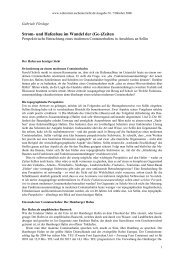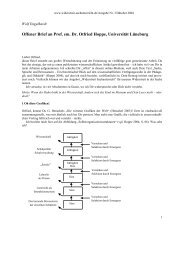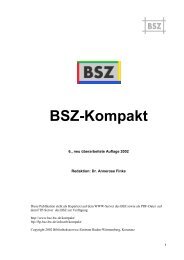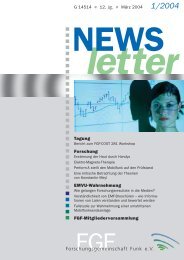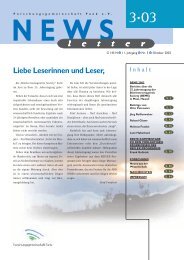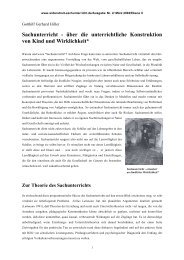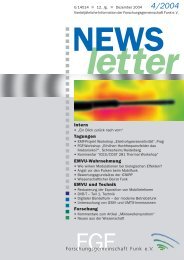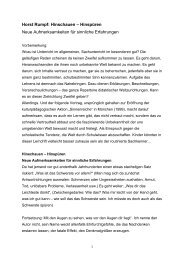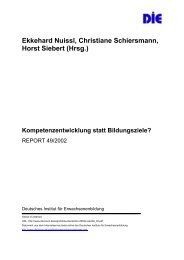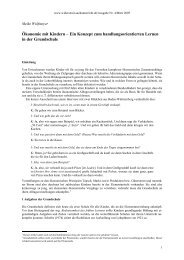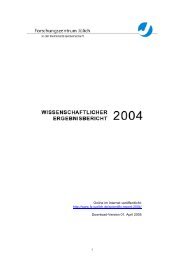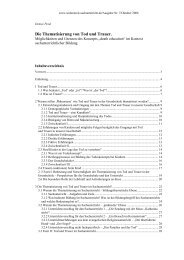Targeted differential display of abundantly expressed sequences ...
Targeted differential display of abundantly expressed sequences ...
Targeted differential display of abundantly expressed sequences ...
You also want an ePaper? Increase the reach of your titles
YUMPU automatically turns print PDFs into web optimized ePapers that Google loves.
from P. chrysosporium, or from unspliced transcripts <strong>of</strong><br />
cbhI.1 and cbhI.2. Firstly, more abundant classes <strong>of</strong> transcript<br />
may out-compete rarer classes in the PCR. Such competition<br />
may explain the failure to detect unspliced transcripts<br />
<strong>of</strong> cbhI.1 and cbhI.2, as the fully spliced transcripts<br />
are more <strong>abundantly</strong> synthesised after growth on these substrates<br />
and may thus have out-competed them (Sims et al.<br />
1994; Birch et al. 1995). Such a bias <strong>of</strong> DDRT-PCR towards<br />
high copy number cDNAs has been demonstrated<br />
previously (Bertioli et al. 1995). Secondly, there may be<br />
insufficient identity between the degenerate primers and<br />
the CBD-encoding regions within the cellulase genes. This<br />
is the case for the cbh1-2 gene, which contains a region<br />
coding for SQCGGLG; this differs from equivalent <strong>sequences</strong><br />
chosen for the design <strong>of</strong> primers 1, 2 and 3 and,<br />
indeed, is different to analogous regions in any other<br />
known fungal CBD (Fig. 4). Thirdly, the CBD-encoding<br />
regions <strong>of</strong> all <strong>sequences</strong> isolated in this study are located<br />
at the 3′ ends <strong>of</strong> the ORF. In the case <strong>of</strong> cbhII, this region<br />
is present at the 5′ end <strong>of</strong> the ORF. Use <strong>of</strong> a specific primer<br />
for cbhII confirmed that cDNAs derived from this gene<br />
were present in samples prepared after growth on Avicel,<br />
CMC, and xylan. However, when using CBD-specific<br />
primer 1, cbhII cDNA templates were out-competed in all<br />
PCR reactions by templates yielding smaller amplification<br />
products, including those from cbhI.1 and cbhI.2 in the<br />
cases <strong>of</strong> Avicel and CMC. Although such competition may<br />
be due simply to different levels <strong>of</strong> gene expression, the<br />
abundance <strong>of</strong> cbhII templates relative to those from cbhI.1<br />
and cbhI.2 may also be effected by the efficiency <strong>of</strong> cDNA<br />
synthesis, which is primed from the 3′ end <strong>of</strong> mRNA. In<br />
addition, the larger PCR product predicted from cbhII<br />
cDNA may be amplified less efficiently than the small PCR<br />
products isolated in this study. Both <strong>of</strong> these factors should<br />
be considered when designing degenerate primers to target<br />
a family <strong>of</strong> genes. It is thus recommended that conserved<br />
<strong>sequences</strong> should be sought which are present at<br />
only one location in all known genes in the family and that<br />
the location should be as near to the 3′ end as possible.<br />
Interestingly, partial protein sequence from one <strong>of</strong> the<br />
EGs produced by P. chrysosporium, EG1, has revealed an<br />
N-terminal CBD containing the sequence GQCGGIG<br />
(Uzcategui et al. 1991 b), identical to those encoded by<br />
equivalent nucleotides in cbhI.1, cbhI.2 and cbhII, from<br />
which primer 1 was designed. As was the case for cbhII,<br />
however, cDNAs coding for this gene were also not detected.<br />
Further work will be required to identify the genes from<br />
which the three novel cDNAs containing CBD-encoding<br />
regions are derived. However, they may originate from<br />
transcripts <strong>of</strong> the partially characterised cbh1-5 and<br />
cbh1-6 (Covert et al. 1992 b) genes, or from the gene that<br />
is predicted to code for both EG38 and EG36 (Uzcategui<br />
et al. 1991 a). Indeed, although Northern analysis would<br />
be required to confirm patterns <strong>of</strong> regulation for these<br />
genes, one sequence isolated in this study, cmc1, was amplified<br />
only from cDNA prepared after growth on CMC,<br />
which is commonly regarded as an EG substrate. In addition,<br />
a cellulose-binding β-glucosidase has been purified<br />
from cellulose-degrading cultures <strong>of</strong> P. chrysosporium and<br />
this too may contain a CBD (Lymar et al. 1995). However,<br />
not all cellulolytic enzymes that bind to microcrystalline<br />
cellulose contain a conventional fungal CBD; this is the<br />
case for cellobiose dehydrogenase from P. chrysosporium<br />
(Li et al. 1996).<br />
In conclusion, the targeted DDRT-PCR approach described<br />
here has been successfully applied to the isolation<br />
<strong>of</strong> novel, abundant cDNA <strong>sequences</strong> containing regions<br />
coding for CBDs and has also confirmed previous observations<br />
on the regulation <strong>of</strong> known genes containing such<br />
regions. Although not a comprehensive screen, the speed<br />
<strong>of</strong> analysis <strong>of</strong> this method makes it attractive for an initial<br />
study <strong>of</strong> more highly <strong>expressed</strong> genes from fungi which<br />
contain such regions. The requirement for only small quantities<br />
<strong>of</strong> mRNA means that a broad number <strong>of</strong> growth conditions<br />
can easily be studied in parallel. In addition, this<br />
approach could readily be adapted to the investigation <strong>of</strong><br />
other gene families, provided sufficient homology exists<br />
between related <strong>sequences</strong> for a general probe to be developed<br />
for the hybridisation-screening <strong>of</strong> cloned cDNAs.<br />
Failing this, additional conserved regions should be sought<br />
within the amplified region which can be used to design<br />
degenerate primers for screening by nested PCR.<br />
Acknowledgements This work was supported by grant RO361<br />
from the Scottish Office Agriculture, Environment and Fisheries Department.<br />
References<br />
75<br />
Béguin P, Aubert J-P (1994) The biological degradation <strong>of</strong> cellulose.<br />
FEMS Microbiol Rev 13:25–58<br />
Bertioli DJ, Schlichter UHA, Adams MJ, Burrows PR, Steinbiß<br />
H-H, Antoniw JF (1995) An analysis <strong>of</strong> <strong>differential</strong> <strong>display</strong> shows<br />
a strong bias towards high copy number mRNAs. Nucl Acids Res<br />
23:4520–4523<br />
Birch PRJ, Sims PFG, Broda P (1995) Substrate-dependent <strong>differential</strong><br />
splicing <strong>of</strong> introns in the regions encoding the cellulose-binding<br />
domains <strong>of</strong> two exocellobiohydrolase I-like genes in P. chrysosporium.<br />
Appl Environ Microbiol 61:3741–3744<br />
Broda P, Birch PRJ, Brooks PR, Sims PFG (1995) PCR-mediated<br />
analysis <strong>of</strong> lignocellulolytic gene transcription by Phanerochaete<br />
chrysosporium: substrate-dependent <strong>differential</strong> expression<br />
within gene families. Appl Environ Microbiol 61:2358–2364<br />
Broda P, Birch PRJ, Brooks PR, Sims PFG (1996) Lignocellulose degradation<br />
by Phanerochaete chrysosporium: gene families and gene<br />
expression for a complex process. Mol Microbiol 19: 923–932<br />
Covert SF, Vanden Wymelenburg A, Cullen D (1992 a) Structure,<br />
organisation and transcription <strong>of</strong> a cellobiohydrolase gene cluster<br />
from Phanerochaete chrysosporium. Appl Environ Microbiol<br />
58:2168–2175<br />
Covert SF, Bolduc J, Cullen D (1992 b) Genomic organisation <strong>of</strong> a<br />
cellulase gene family in Phanerochaete chrysosporium. Curr<br />
Genet 22:407–413<br />
Dalbøge H, Heldt-Hansen HP (1994) A novel method for efficient<br />
expression cloning <strong>of</strong> fungal enzyme genes. Mol Gen Genet<br />
243:253–260<br />
Gilkes NR, Henrissat B, Kilburn DG, Miller RC, Warren RAJ (1991)<br />
Domains in microbial β-1,4-glycanases: sequence conservation,<br />
function and enzyme families. Microbiol Rev 55:303–315<br />
Gold M H, Alic M (1993) Molecular biology <strong>of</strong> the lignin-degrading<br />
basidiomycete Phanerochaete chrysosporium. Microbiol<br />
Rev 57:605–622




